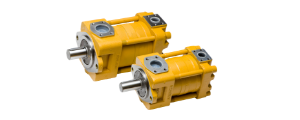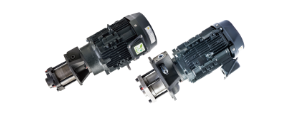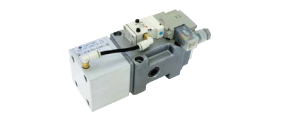Troubleshooting
- 1. Hydraulic pump
- 2. Coolant pump
- 3. Solenoid controlled switching valve
- 4. Balanced piston type relief valve
1. Hydraulic pump
If any of the following abnormalities occur, immediately stop the motor and perform the inspection as follows:
- (A) No hydraulic oil is discharged
-
cause countermeasure Wrong direction of motor rotation. Return to normal rotation. The oil level is low. Add oil up to the upper limit of the oil level gauge. The suction pipe or suction filter is clogged. Clean the intake pipe and suction filter.
If the oil is heavily clogged, replace it with new oil.Air is drawn in through the intake pipe. Check with an oil level gauge that the oil level is appropriate.
Repair the gasket at the piping connection point.
Ensure that the threaded joints of the suction pipe are tightened properly.The pump shaft does not rotate. Check the motor and coupling.
Check whether the pump shaft can be easily rotated with a wrench or similar tool.
If it does not rotate, there may be internal damage to the pump.
- (B) Pressure does not increase
-
cause countermeasure The relief valve pressure setting is low. Use an accurate pressure gauge to adjust to the correct setting. The relief valve is stuck. Disassemble and clean the pressure regulating unit, and repair or replace the parts. There are many leaks in the hydraulic circuit system (cylinder valve). The hydraulic circuit is blocked in sequence, the parts are inspected, and the parts are repaired or replaced. The motor is operating below the lower limit of the rated speed range. Increase the operating speed (within the rated speed).
- (C) It is noisy.
-
cause countermeasure The hydraulic oil in the tank is cloudy due to air bubbles. Check to see if air is being sucked in through the intake piping. The suction pipe and suction filter are partially clogged. Clean the intake pipe and suction filter. The oil temperature is too low. The viscosity is high. Keep the oil temperature at the proper level. Care must be taken when selecting oil. Coupling is worn and misaligned. Replenish grease. Check and adjust centering. Excessive pressure. Reset the pressure. If there are no problems with the above, there may be a problem with the pump. Please contact us.
- (D) Oil temperature rises abnormally
-
cause countermeasure The coolant is not flowing through the cooler. Turn on the cooling water and check that the valves are open and closed. The cooler's cooling pipes are dirty. Clean the cooling pipes. The temperature of the pump body is 25 degrees or more higher than the suction oil temperature. There is a possibility of an abnormal increase in internal leakage due to a pump malfunction, so replace the pump.
2. Coolant pump
If any of the following abnormalities occur, immediately stop the motor and perform the inspection as follows:
Common causes and solutions for coolant pump failures
- (A) No discharge from the pump
-
cause countermeasure Wrong direction of motor rotation.
(Normal: Motor fan rotates clockwise)Immediately stop the motor and reconnect the wires according to the wiring diagram. The liquid level is low. Add liquid up to the upper limit of the level gauge. The suction filter is clogged. Clean the suction filter.
If the filter is clogged, replace it with new fluid.Air is drawn in through the intake port. Use a level gauge to check that the liquid level is appropriate.
Repair the gasket at the piping connection point.
Or tighten it sufficiently.The pump shaft does not rotate. Check whether the motor fan can be easily rotated by hand.
If it does not rotate, there may be internal damage to the pump.
- (B) Pressure does not increase
-
cause countermeasure The relief valve pressure setting is low. Use an accurate pressure gauge to adjust to the correct setting. The relief valve is stuck. Disassemble and clean the pressure adjustment unit, and repair or replace the parts. There are many leaks in the circuit system. The circuits are blocked one by one, the parts are inspected, and the parts are repaired or replaced.
- (C) Pump noise
-
cause countermeasure The liquid in the reservoir is cloudy and contains air bubbles. Check to see if air is being sucked into the suction pipe. The suction filter is partially clogged. Clean the suction filter.
- (D) Abnormal heat generation in the pump
-
cause countermeasure Wear of the pump itself (wear of the sliding parts) Replacing the pump. Excessive pressure. Reset the pressure. No liquid is being aspirated. See section (A)
- (E) Liquid temperature rises sharply
-
cause countermeasure An abnormal increase in internal leakage due to a pump malfunction. Replacing the pump.
Common motor failure causes and solutions
- (A) Does not start without load
-
cause countermeasure Not energized. Check that the power is on. Two of the connecting wires are faulty. Fix the defective part. Switch/starter operation or contact failure. Check the connecting wires and parts.
- (B) Abnormal noises
-
cause countermeasure Wear and tear on bearings. Replace the bearings. It is in single-phase operation. Check the power supply with a voltmeter.
- (C) Rotate in the opposite direction
-
cause countermeasure Wiring error. Reconnect the wires according to the wiring diagram.
- (D) The fuse blows.
-
cause countermeasure Winding or lead wire is shorted. Check for and repair the short circuit. The load is heavy. Reduce the load to an appropriate level. The fuse capacity is insufficient. Replace it with the appropriate one.
- (E) Rotation speed does not increase
-
cause countermeasure Wrong connection of star-delta starter. Reconnect correctly.
- (F) Groaning
-
cause countermeasure Contact between the rotor and stator causes excessive current and heat generation. Motor replacement and repair. The spacing between the rotor and stator is uneven. Motor replacement and repair. One phase of the stator winding is short-circuited. Motor replacement and repair.
- (G) The overcurrent relay operates;
The switch heats up -
cause countermeasure Incorrect relay selection, insufficient switch capacity. Replace it with the appropriate one. The load is heavy. Reduce the load to an appropriate level.
- (H) Overheating
-
cause countermeasure Power imbalance. Contact your power company. Voltage drop. Contact your power company. The load is heavy. Reduce the load to an appropriate level.
- (I) A sudden decrease in speed
-
cause countermeasure Voltage drop. Contact your power company. The load is heavy. Reduce the load to an appropriate level. Faulty star-delta starter. Adjust the contact area.
3. Solenoid controlled switching valve
If any of the following abnormalities occur, immediately check the following:
Common causes and solutions for solenoid valve malfunctions
- (A) Poor flow path switching
-
cause countermeasure Foreign matter has entered the sliding part of the spool Disassemble and clean the valve. If the hydraulic oil is contaminated, flush it or replace it with new oil. Distortion of the solenoid switching valve body. Tighten the mounting bolts to the required torque (6.9 Nm). Check the surface roughness (Rzm6.3) and parallelism (0.01/100mm) of the contact surface. Excessive pressure and flow. Compliance with standard specifications. Solenoid related fault. Continuity check between terminals. Check the electrical wiring. Tank port pressure is excessive. Compliance with standard specifications.
- (B) Abnormal noise when switching
-
cause countermeasure Excessive pressure and flow. Compliance with standard specifications. Air remaining in the circuit. Complete air removal.
- (C) Switch to reverse flow direction
-
cause countermeasure Miswiring. Check the wiring instructions. Check the piping ports.
- (D) Solenoid coil burnout
-
cause countermeasure Incorrect power supply voltage. Use with the correct power supply voltage. Simultaneous energization (both SOL types) Use only one side with power on. Temperature (ambient, oil) abnormal. Compliance with standard specifications. Spool stuck. Disassemble and clean the valve. If the hydraulic oil is contaminated, flush it or replace it with new oil. *Do not use a burnt coil.
- (E) External oil leakage
-
cause countermeasure Mounting bolts not tightened properly. Tighten the mounting bolts to the required torque (6.9 Nm). O-ring damaged or deteriorated. Replace with a new O-ring. Nut or cartridge loose. Observe the nut tightening torque (4.4 Nm) and cartridge tightening torque (26.8 Nm).
4. Balanced piston type relief valve
If any of the following abnormalities occur, immediately check the following:
Common causes and solutions for relief valve failures
- (A) The pressure is too high or too low
-
cause countermeasure Foreign matter has entered the sliding part of the spool The pressure setting is incorrect. The vent circuit is open. Block the vent circuit. Piston malfunction. Remove the piston and check that there is no debris stuck in the small diameter part, then clean it thoroughly. Move the piston by hand to check if it moves smoothly. If necessary, correct it according to item 8-3). Pilot valve malfunction. Check the pilot seat for holes or debris, and make sure the poppet is seated properly, and clean it thoroughly. The pressure gauge is not working properly. Check the pressure gauge and the piping and valves leading to the pressure gauge. No oil comes out of the pump. Inspect and treat the pump.
- (B) Unstable pressure
-
cause countermeasure Air is mixed in the oil. Remove the air from the circuit and check whether air has been sucked into the pump suction pipe, pump shaft, suction filter, etc. If air has been sucked into the pump, re-pipe those areas. There is dirt in the oil. Check for any dirt on the seat surface, sliding parts between the piston and body, or control parts, and clean them thoroughly. If the oil is very dirty, replace it with new oil. Piston malfunction. Check the sliding parts of the piston and body, and replace them if they are worn out. If the wear is small and the piston does not move smoothly, remove any burrs from the body and piston. The pilot poppet is not hitting the seat properly. Check that the contact surface between the poppet and seat is not damaged. If there is damage, fix it. Tank line back pressure fluctuates. Check the tank piping and if it joins with other tank lines, connect it directly. The oil flow rate is greater than the allowable flow rate. Replace with a larger size valve.
- (C) Oil leak
-
cause countermeasure Damaged valve parts. Replace the part. Incorrect tightening torque of mounting bolts. Tighten to the specified tightening torque. O-ring damage. Replace the O-ring. Valve damage. Replace the valve.
- (D) Abnormal noise or vibration occurs.
-
cause countermeasure Resonating with the vent circuit (when using a vent port). Remove the air by inserting a restriction near the vent port.



